Creating accessible pools for disabled swimmers requires implementing ADA-compliant features like pool lifts, zero-entry designs, or movable floors. You’ll need at least one accessible entry method for small pools or two for larger facilities. Consider slip-resistant surfaces, proper installation clearances, and specialized aquatic wheelchairs to enhance mobility. Staff training guarantees proper operation and maintenance of accessibility equipment. Discover how these thoughtful design elements can transform your facility into an inclusive aquatic environment for all abilities.
Understanding ADA Requirements for Pool Access
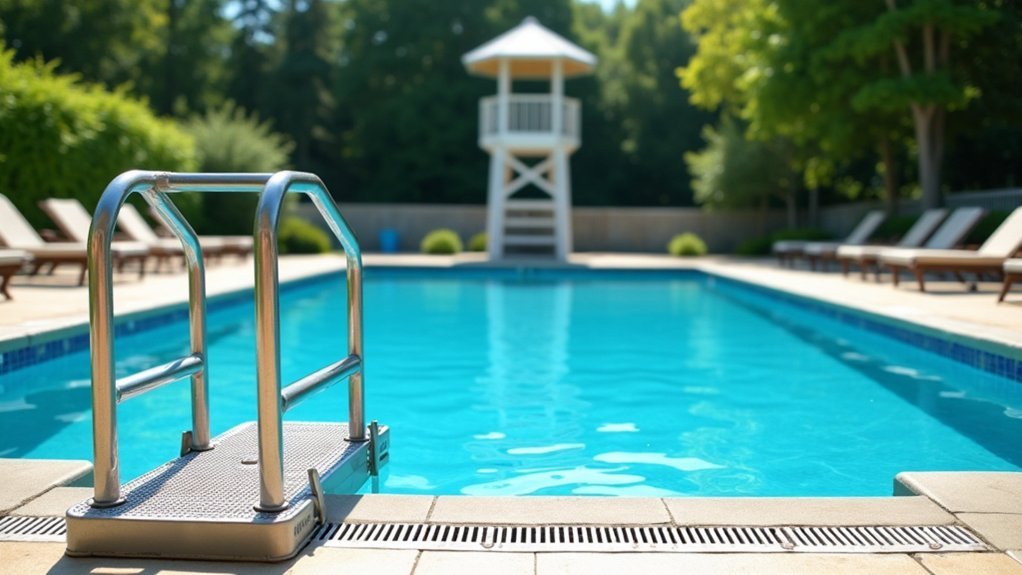
When planning an accessible swimming pool, understanding the Americans with Disabilities Act (ADA) requirements is essential. Title III of the ADA mandates accessibility in public pools, with rules that took effect in May 2012 for non-residential facilities.
Your requirements vary by pool size: large pools (over 300 linear feet) need two accessible entry means, while smaller pools require just one. For new or altered pools, you’ll need fixed pool lifts capable of independent operation or sloped entries as primary access options.
Secondary methods include transfer walls, systems, and stairways. Each type must meet specific dimensions—for example, grab bars on transfer walls must have a circular cross-section diameter of 1¼ to 2 inches.
For existing facilities, you’re only required to make improvements when readily achievable without significant hardship.
Remember that all accessibility equipment must remain operational during all pool hours, with staff properly trained to assist disabled swimmers.
Movable Pool Floors: Versatility for All Abilities
Movable pool floors represent one of the most versatile accessibility solutions available for modern swimming facilities.
These innovative systems allow you to adjust water depth within minutes, accommodating users of all abilities and transforming a single pool into a multi-purpose venue. They create gradual entry points that eliminate the need for ladders or stairs, benefiting those with mobility challenges. The floors can be positioned to create sloping surfaces that allow convenient entry and exit for all users.
Key advantages include:
- Therapeutic applications with customizable depths that reduce joint stress and enhance flexibility
- Enhanced accessibility features like wheelchair compatibility and slip-resistant surfaces
- Safety measures including edge detection systems and visual warnings during operation
You’ll appreciate how these floors combine with other accessibility equipment like pool lifts and transfer devices, creating an inclusive environment where everyone can enjoy the physical and psychological benefits of swimming.
Pool Lifts: Selection and Implementation Guidelines
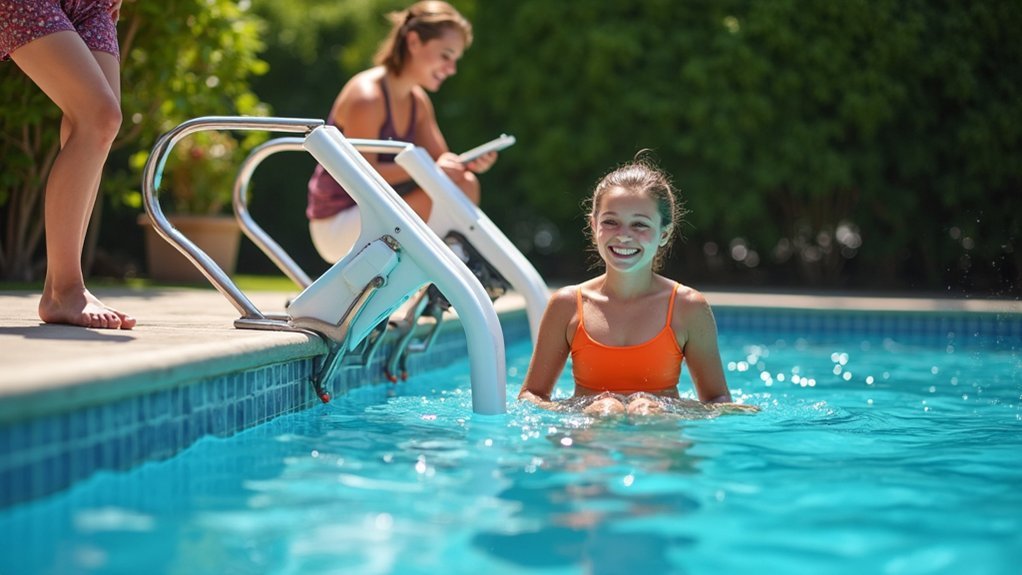
When selecting an ADA-compliant pool lift, you’ll need to verify the weight capacity exceeds 300 pounds and guarantee it can be operated independently by users with disabilities.
Your installation must include clear deck space of at least 36 inches and position the lift where water depth doesn’t exceed 48 inches.
Remember to train your staff on proper operation and maintenance procedures, including regular safety checks to keep the lift functioning effectively for all swimmers. Implementing quarterly maintenance schedules for your pool lift ensures its reliability and contributes to a consistently accessible aquatic environment for all users.
Choosing ADA-Compliant Lifts
Selecting the right pool lift stands as one of the most critical decisions when creating accessible swimming facilities. When evaluating options, you’ll need to confirm your lift meets all ADA requirements, including the 300-pound minimum weight capacity and 16-inch-wide solid seat.
- Consider your facility’s specific needs—stationary lifts offer permanence for public pools, while portable options provide flexibility for facilities with multiple pools.
- Verify the lift allows for independent operation from both deck and water positions, with easily accessible controls that don’t require grasping or twisting.
- Don’t overlook required features like footrests and clear deck space (minimum 36″ × 48″) with a slip-resistant surface and minimal slope.
Remember that daily inspections and following manufacturer maintenance schedules confirm continued safety and compliance. Evaluating the lift’s lift range is essential to ensure it can properly accommodate your pool’s depth and provide the minimum 18 inches of clearance above the water level.
Installation Best Practices
Proper installation of pool lifts ultimately determines their effectiveness, safety, and compliance with ADA standards.
You’ll need to position lifts where water depth doesn’t exceed 48 inches to guarantee user safety and easier assistance if needed.
Ascertain you have adequate clear deck space around the lift for smooth wheelchair transfers and staff assistance.
Install slip-resistant surfaces and proper lighting to prevent accidents.
The lift should allow independent access to the pool for users with mobility limitations without requiring assistance from others.
Consider maintenance access during installation—you’ll need regular equipment checks for corrosion and wear.
When planning your installation, think beyond the immediate setup.
Integrate your lift with other accessibility features like transfer walls and non-slip surfaces.
Train your staff thoroughly on proper operation and maintenance procedures.
Remember that proper installation isn’t just about meeting requirements—it’s about creating truly accessible aquatic experiences for all users.
Submersible Wheelchairs and Aquatic Mobility Devices
Numerous innovative aquatic mobility solutions have transformed pool accessibility for disabled swimmers in recent years.
These specialized wheelchairs, constructed from corrosion-resistant materials, allow users to safely shift from deck to water while maintaining independence.
Popular options include:
- The AquaActive with its ergonomic design and adjustable seating
- DeBug Aquatic models supporting up to 400 lbs while weighing just 35 lbs
- AquaTrek chairs made from durable PVC and stainless steel components
You’ll find most submersible wheelchairs feature adjustable components for maximum comfort and customization. For example, the DeBug Aquatic Submersible Wheelchair offers adjustable seat width options of 14, 18, or 22 inches to accommodate different body types.
Beyond physical accessibility, these devices deliver significant emotional benefits, providing newfound freedom and confidence in aquatic environments.
When integrated with proper pool lifts and accessible routes, submersible wheelchairs create truly inclusive swimming experiences.
Zero-Entry Designs: Benefits for Therapeutic Swimming

Zero-entry pools offer exceptional therapeutic benefits through their beach-like gradual slope that’s ideal for rehabilitation.
You’ll experience reduced joint stress and muscle tension as the water’s buoyancy creates a low-impact environment perfect for recovering from spinal injuries, back problems, and ACL tears.
The gentle shift from dry land to deeper water allows you to progress at your own pace, making these designs particularly valuable for therapeutic swimming programs. The sloped entrance provides easier entry and exit for individuals with mobility challenges, increasing independence during aquatic therapy sessions.
Rehabilitation Through Gentle Entry
While traditional pool entries present significant barriers for those with mobility challenges, zero-entry designs offer revolutionary benefits for therapeutic swimming programs.
You’ll find these gradual slopes mimic natural beach entries, providing a seamless passage from dry land to water that’s ideal for rehabilitation purposes.
The therapeutic advantages of zero-entry pools include:
- Low-impact exercise opportunities that protect sensitive joints while promoting strength building
- Confidence-building features that encourage independent access for those with disabilities
- Variable depth options that accommodate different therapeutic needs and progressive rehabilitation stages
When you’re recovering from injury or managing chronic conditions, you’ll appreciate how these pools facilitate smooth water entry without the jarring movements stairs require.
The non-slip surfaces and optional handrails further enhance safety during therapeutic sessions, making rehabilitation both effective and dignified.
Incorporating warm water and hydrotherapy jets can provide significant relief for seniors suffering from joint pain while they engage in therapeutic swimming activities.
Aquatic Therapy Applications
The rehabilitation potential of zero-entry pools extends far beyond simple accessibility, creating ideal environments for structured aquatic therapy programs.
You’ll find these designs particularly effective for orthopedic rehabilitation, allowing early mobility after surgery while preventing joint stiffness and pain.
If you’re managing chronic pain, the warm water and gentle sensory stimulation can greatly improve your comfort levels. The buoyant environment reduces stress on painful joints by decreasing the effects of gravity on your body.
The pool’s resistance jets and underwater treadmills offer customized strength training options without stressing your joints. You can also improve your cardiovascular health through low-impact aerobic exercises tailored to your specific fitness level.
For those with neurological disorders, zero-entry pools provide an ideal setting to enhance balance and motor skills.
The gradual slope design creates a continuum of water depths, allowing your therapist to progress treatment safely as your abilities improve.
Hoists and Transfer Systems: Installation Considerations
Installing a pool hoist system requires careful planning to guarantee safety, accessibility, and compliance with regulations. When selecting a hoist, you’ll need to evaluate your specific needs and pool configuration.
- Match to pool type: Verify your chosen system aligns with your deck configuration, whether you have an in-ground or above-ground pool.
- Consider weight capacity: Select a hoist that exceeds the maximum user weight to maintain safe operation margins.
- Verify mounting requirements: Fixed hoists need secure anchoring to prevent movement during transfers, while portable options require proper anchoring systems in commercial settings.
Remember to maintain a clear transfer area—typically 36 inches wide and extending 48 inches from the seat—and install the lift where water depth doesn’t exceed 48 inches for best assistance. For commercial facilities, ensure your pool lift meets the ADA compliance requirements of supporting at least 300 pounds capacity and having proper securing mechanisms.
Slip-Resistant Surfaces and Safety Features
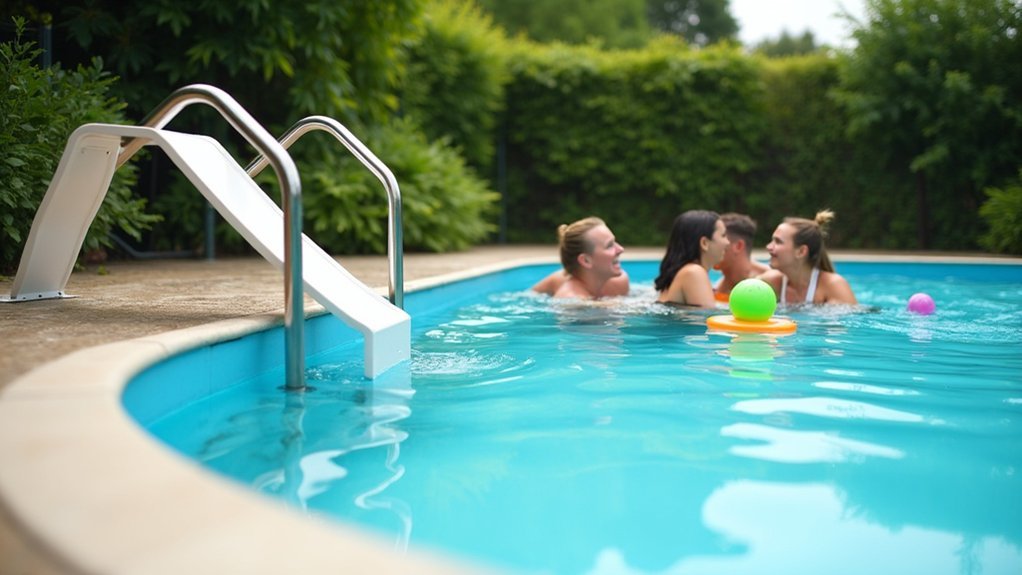
Safety underfoot represents a critical component of accessible pool design where disabled swimmers are concerned.
You’ll need slip-resistant surfaces made from durable materials like nitrile rubber or PVC that meet rigorous standards such as DIN 51097 and ASTM 1677.
For wet areas, consider options like Versa Runner matting with its open-grid design that promotes drainage while providing antimicrobial protection. The diamond tread pattern on Vynagrip Heavy-Duty matting offers superior traction in demanding environments.
Your pool deck, locker rooms, and shower areas should all feature textured surfaces that prevent slips and falls.
Don’t overlook integrated safety features like movable pool floors with gradual entry access and edge detection systems.
These components work alongside ADA-compliant elements such as properly sized grab bars (1.25-1.5 inches in diameter) and transfer walls with rounded, non-sharp surfaces to create a thorough safe swimming environment.
Designing Multi-Sensory Pool Environments
Multi-sensory pool environments transform accessibility into an immersive experience that engages all senses, not just physical needs. When you’re designing these spaces, incorporate LED color wash lighting and high-quality waterproof sound systems to create a therapeutic atmosphere that stimulates relaxation and improves coordination.
Beyond accessibility, multi-sensory pools create immersive experiences through thoughtful design that engages all senses and promotes therapeutic benefits.
For a truly inclusive environment, consider these elements:
- Interactive systems with air or radio-based switching that allow users to control their experience
- MSE+ systems utilizing wireless Bluetooth technology for customizable sensory stimulation
- Visual projections and fiber optics that create dynamic, engaging visual experiences
Remember to implement universal design principles throughout your facility, ensuring the environment is flexible enough to accommodate various abilities and preferences. The comprehensive IRiS Pool Director Software seamlessly integrates all sensory pool elements while offering various themes for learning and calming experiences.
This approach doesn’t just satisfy regulations—it creates spaces where everyone feels welcome and empowered.
Training Staff for Inclusive Aquatic Programs
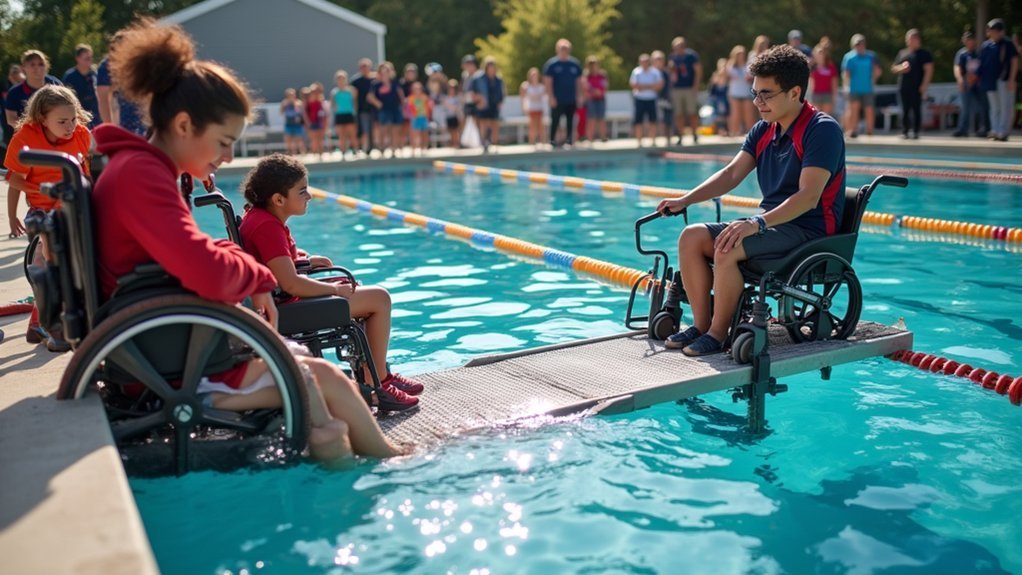
Training and preparing your aquatic staff properly serves as the cornerstone of truly inclusive swimming programs. Focus on education about disabilities, communication strategies, and adapting standard practices while maintaining safety. Equip your team with skills to recognize atypical behaviors and respond appropriately. Prioritize understanding that individuals with autism spectrum disorders are significantly more at risk of accidental drowning than their neurotypical peers.
| Training Focus | Key Components | Implementation |
|---|---|---|
| Communication | Simple language, visual aids, gestures | Daily practice sessions |
| Safety Protocols | Elopement prevention, sensory accommodations | Scenario-based training |
| Adaptability | Modified rules, flexible grouping | Regular staff workshops |
Encourage your staff to build relationships with specialists before participants arrive. Implement continuous evaluation through participant feedback to refine your programs. Remember that effective staff training directly impacts how welcome and safe disabled swimmers feel in your aquatic environment.
Frequently Asked Questions
What Are the Maintenance Costs for Accessible Pool Equipment?
You’ll face varied maintenance costs for accessible pool equipment. You’ll spend $300-$600 annually on chemicals, $60-$1,500 for filter maintenance, and $75-$100 hourly for regular inspections to extend equipment lifespan.
How Long Does Installation of Accessibility Features Typically Take?
You’ll find installation timelines vary: pool lifts take 1-7 days, zero-depth entries add 1-2 weeks to construction, and handrails require 1-2 days. Overall, expect accessibility features to add 2-4 weeks to your project.
Are There Tax Incentives for Adding Accessibility Features?
Yes, you’ll find tax incentives available for accessibility improvements. You can claim up to $5,000 in tax credits (for small businesses) or deductions up to $15,000 (for all businesses) annually for eligible expenses.
Can Accessible Features Be Retrofitted to Existing Residential Pools?
Yes, you can retrofit your existing residential pool with accessibility features like lifts, ramps, or transfer systems. Consider consulting professionals to assess space requirements and guarantee proper installation that meets safety standards.
How Do Weather Conditions Affect Outdoor Accessible Pool Equipment?
Weather conditions greatly impact your outdoor pool equipment. You’ll find that extreme temperatures, rain, and storms can damage lifts, create slippery surfaces, and affect transfer systems if you don’t properly maintain and protect them.
In Summary
You’ve now got the tools to make your pool accessible to swimmers of all abilities. Remember, it’s not just about meeting ADA requirements—it’s about creating welcoming spaces where everyone can enjoy the water. With the right equipment, thoughtful design, and properly trained staff, you’ll transform your facility into an inclusive environment that celebrates swimming as a universal joy.

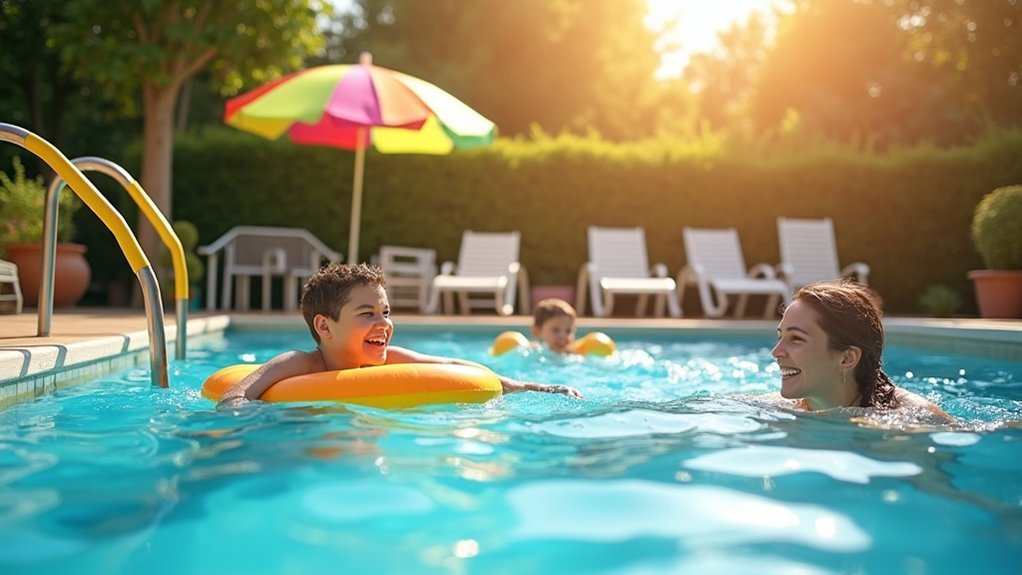



Leave a Reply